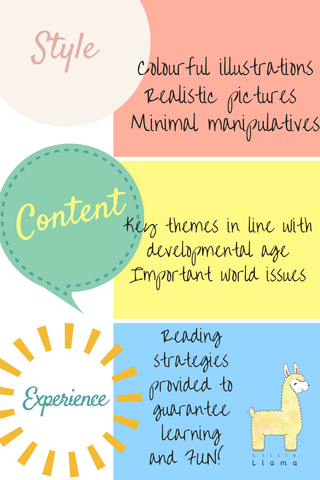Choosing the right book for your child
"My daughter really enjoyed that book, where did you buy it from? I can never find such books, or choose the right book!"
As a speech and language therapist, I often get questioned by perplexed parents about where and how I go about choosing the right book for their children. What exactly, is a book of high quality?
Very often, I like to take them on a thought experiment and probe them about what they think "good quality" means. It turns out that parents have varying definitions. One parent might evaluate "good quality" as being able to capture a child's attention. For another, the book has to contain learning points for the child. In reality, do certain books deserve a higher standing?
The book you buy and how you read it matters!
Research has shown that certain book features do have effects on children's learning. I will discuss these features, and how this relates to Little Llama’s book collections further on. More importantly, all parents should understand that how we read to our children matters the most!
Emilie Buchwald once said, “ children are made readers in the laps of their parents”. At Little Llama, we believe children are made thinkers in the laps of parents who read with them. We believe in advocating every parent to be the facilitator of this magical journey into books.
Style, content and the experience

Immense effort is invested into choosing books with realistic, colourful illustrations, especially for our younger children. Simcock and DeLoache (2006), in their article titled “Get the picture? The effects of iconicity on toddlers‟ reenactment from picture books” suggested that 2 year olds learn best from realistic colour photos and colourful illustrations rather than black and white drawings. As children grow older, they develop better symbolic understanding. This is when abstract illustrations are more suitable.
What about books with lifts and flaps? Are they the right choice?
Our team believes that these books might be suitable for younger children below the age of 4, as well as those with language impairments. The manipulative component of such books can increase engagement levels and lead to greater language expression. However, it might be distracting for older children. For more information on this topic, check out this article written by The Hanen Centre.
Books at Little Llama are also curated and recommended based on developmental stages and levels of ability, not strictly by age.
They range from early concepts such as shapes, colours and body parts and progress to include more abstract concepts such as dealing with feelings and other world issues.
Most importantly, our team at Little Llama cares about helping every parent to harness the power of transforming reading time into an exhilarating learning journey.
Enter the Gateway to Play … and joyful reading!
References
Kaderavek, J. & Sulzby, E. (1998). Parent-Child Joint Book Reading: An Observational Protocol for Young Children. American Journal of Speech-Language Pathology, 7(1), 33-47.
Simcock, G. & DeLoache, J. (2006). Get the picture? The effects of iconicity on toddlers' reenactment from picture books. Developmental Psychology 42(6), 1352-1357.
-----------------------
Where to start
We have grouped our collections for your convenience, check them out here:
0-3 years: Discoverer
3-5 years: Explorer
5-7 years: Creator
